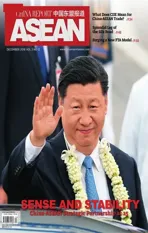CHINA-ASEAN: SETTING A GOLD STANDARD IN TRADE RELATIONS
2018-12-25ByZhaoJianglin
By Zhao Jianglin
The 21st China-ASEAN Summit in November was particularly significant after ‘tit-for-tat’ trade relations between China and the United States began impacting the development trends of China-ASEAN economic and trade environment, which, however,also motivated a close examination of the quality of China-ASEAN economic ties over the past years.
A Solid Foundation to Withstand Risk
After enduring multiple tests, economic and trade relations between China and ASEAN have evolved into an indestructible cooperative relationship. Early in the 1990s, China-ASEAN cooperation already embarked on an extraordinary journey. Over the years, the countries have stood the tests of the 1997 Asianfinancial crisis, the 2008 globalfinancial crisis and South China Sea disputes. Each of these major tests propelled China-ASEAN economic and trade relations forward rather than drawing them back.
In 2003, the China-ASEAN strategic partnership was established to foster peace and prosperity. The China-ASEAN Free Trade Area was established in 2010, and the framework for a code of conduct in the South China Sea was adopted in 2017. China has been the largest trading partner of ASEAN for nine consecutive years so far, and ASEAN has been the third largest trading partner of China for seven years in a row.
China-ASEAN cooperation has made substantial progress infields of education, culture, tourism and technology. In tourism, two-way arrivals between China and ASEAN jumped to nearly 50 million in 2017 from more than 30 million in 2016. The combined volume of overseas students from China and ASEAN exceeded 200,000. Frequent and close bilateral cooperation and relations that have endured many tests have laid a solid foundation for all sides to protect themselves against external risk.
In the past, a changing global situation greatly impacted China-ASEAN economic and trade relations, but now the relationship is the other way around, having the ability to withstand major world challenges. A main criterion in determining a country or region’s market capacity is assessing its ability to withstand global economic risk. In years past,economic and trade relations between China and ASEAN were highly dependent on the world market because the two sides had established an industrial cooperation relationship targeting a third-party market. This system involved China importing raw materials, components and parts from ASEAN which were later processed and assembled in China before being exported to mostly developed countries. This type of economic and trade structure depended highly on the world environment.
Today, China-ASEAN economic and trade relations have evolved from singular industrial cooperation to a comprehensive relationship featuring reciprocal market access, especially with China becoming a huge market for ASEAN. This relationship has substantially improved on the former situation, in which development of China-ASEAN relations was restrained by global forces.
In 2017, total bilateral trade volume between China and ASEAN was approximately US$514.8 billion, of which China’s exports to ASEAN measured about US$279.1 billion,an increase of 9 percent year-on-year. China spent about US$235.7 billion on imports from ASEAN, up 20 percent from 2016.
Consumption trends are particularly important these days.China’s imports of consumer products from ASEAN reached US$15.8 billion in 2017, up from just US$4.9 billion in 2007,and China’s exports of consumer products to ASEAN increased to US$49.4 billion in 2017 from US$15.8 billion in 2007.
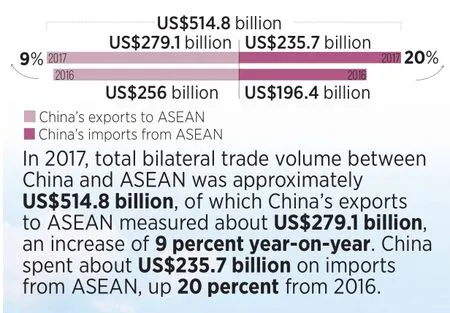
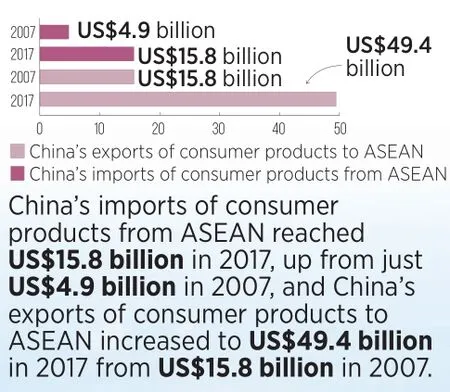
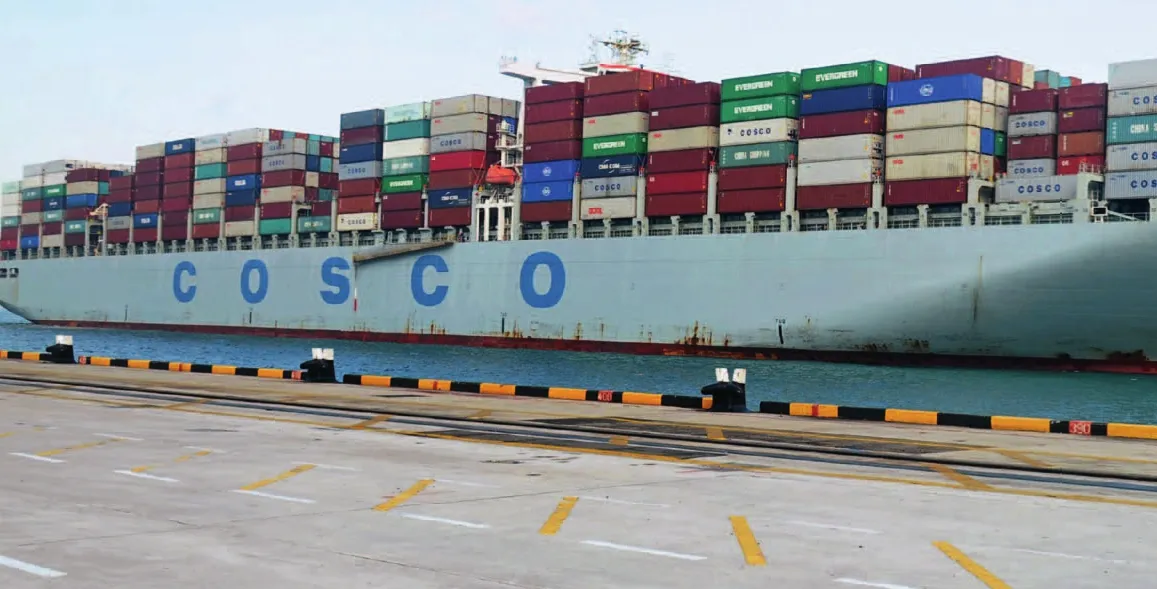
A container ship of China Ocean Shipping Company (COSCO) at the Port of Singapore, the largest port in Southeast Asia and a major global hub.
Thefirst China International Import Expo, convened in Shanghai in November, saw China transform into a major export destination for products from around the world.
New Economic and Trade Relations
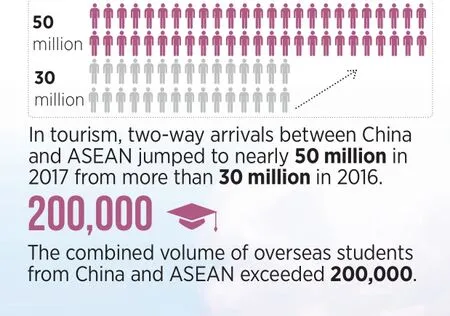
Since China proposed the initiative to jointly build the 21st Century Maritime Silk Road in 2013, China and ASEAN have continued to introduce new concepts and ideas to jointly create a new pattern of win-win cooperation in economics and trade. Some have claimed that the so-called win-win cooperation creates greater benefits for China than for ASEAN. Ultimately, each ASEAN country is responsible for determining how much it will benefit from cooperation with China, they say.
Such criticism holds little weight. A prosperous ASEAN is better for China than a struggling ASEAN.
Specifically for this reason,China has been actively improving its trade surplus with ASEAN. In 2015, China’s trade surplus with ASEAN was more than US$80 billion, but it dropped to US$60 billion in 2016 and further decreased to barely US$40 billion in 2017.
At the same time, China has been increasing its investment in ASEAN to improve the local manufacturing capacity and increase employment. In 2017,China’s combined stock of foreign direct investment in 10 ASEAN countries was US$88.36 billion, up 23.5 percent from 2016.
According to Mergermarket data, investment from combined mergers and acquisitions that Chinese companies conducted in ASEAN countries reached US$34.1 billion in 2017, up 268 percent year-on-year, accounting for 77 percent of the total transaction volume of Chinese investment in Asia.
There are also some who claim that China is dividing ASEAN,which is also not true. China is well aware that a consolidated ASEAN market is more conducive to industrial division between China and ASEAN, which will improve efficiency of resource allocation and enhance the region’s ability to resist external risk.
Today, China is taking a comprehensive, positive and pragmatic approach to forging brand new China-ASEAN economic and trade relations that align with the concept of building a closer China-ASEAN community of shared future. Both sides will create tremendous opportunities for each other,laying a more solid material basis for a China-ASEAN community of shared future.
ASEAN Plus Three (China, Japan, South Korea)Macroeconomic Research Office (AMRO) estimates that China’s GDP will reach US$30 trillion in 2035, of which consumption will account for 60 percent and create a huge market for ASEAN and the world at large.AMRO also predicts that from 2018 to 2035, the total value of ASEAN’s exports to China will reach US$10 trillion, and combined Chinese investment in ASEAN is expected to reach more than US$400 billion.
According to AMRO, by 2035, Chinese tourists to ASEAN are expected to number 72 million and consume a combined US$100 billion. ASEAN is also creating new opportunities for China’s economic development. ASEAN has a younger population and a faster economic growth rate, making it one of the most important consumer markets in the world.AMRO predicts that by 2035, ASEAN’s economic growth rate will reach 6 percent, and the combined GDP of 10 member states is expected to reach US$7.8 trillion across a total population of 750 million.
At the 20th China-ASEAN Summit in 2017, the two sides announced the formulation of China-ASEAN Strategic Partnership Vision 2030, designated 2018 as China-ASEAN Year of Innovation, and adopted Joint Statement between ASEAN and China on Further Deepening the Cooperation on Infrastructure Connectivity as well as other documents on connectivity, anti-corruption, tourism and environmental protection. We are convinced that China-ASEAN relations are becoming the gold standard for win-win cooperation between developing countries.
